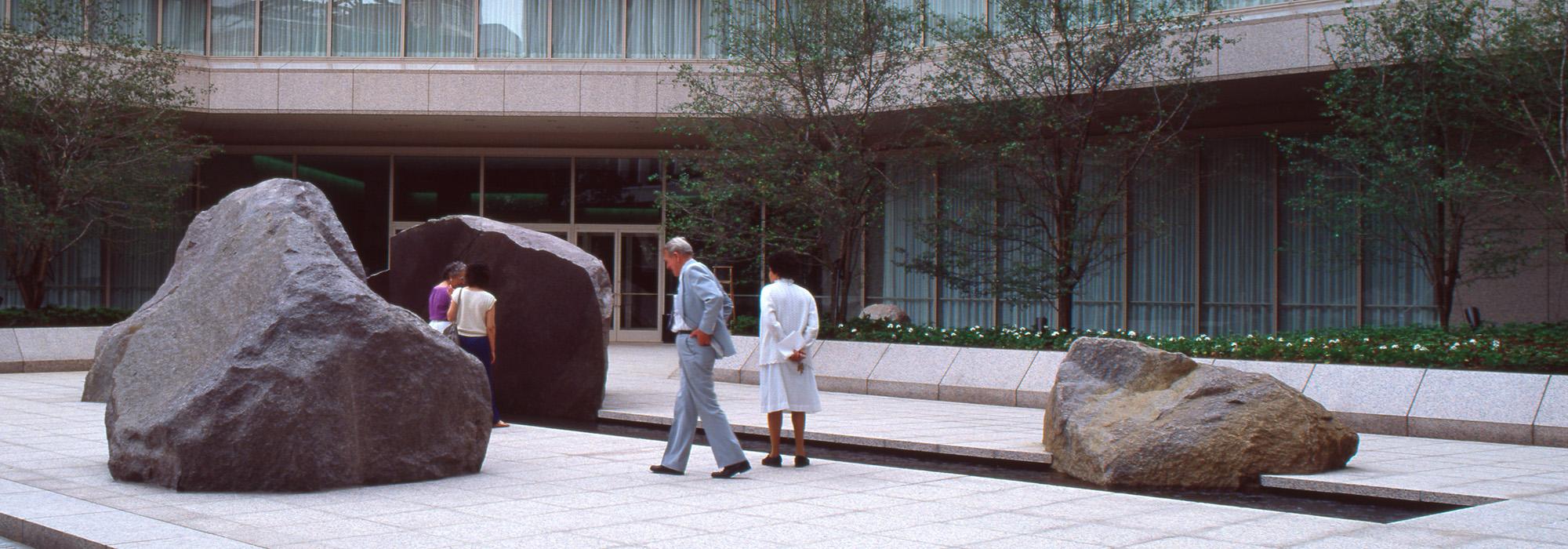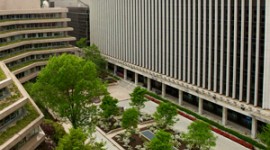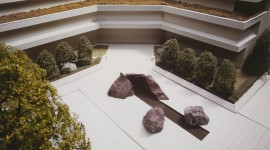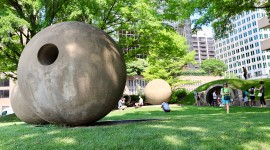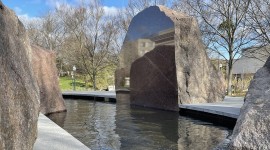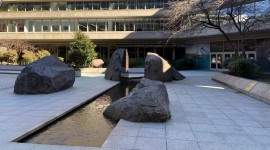National Geographic to Demolish Widely Acclaimed Sculpture MARABAR
Located in the heart of the nation’s capital, the National Geographic headquarters is home to the organization whose name is synonymous with global exploration and discovery. The headquarters comprises buildings by Edward Durell Stone and Skidmore, Owings & Merrill, giants in the field of twentieth-century architecture. The centerpiece of the architectural ensemble is a publicly accessible plaza that for 35 years has been a source of delight to all who discover the celebrated work of art that resides there: Marabar, by award-winning American sculptor Elyn Zimmerman. But now, this first large-scale stone project in the artist’s repertoire is slated to be demolished to accommodate a new pavilion.
History:
Founded in Washington, D.C., in 1888, the National Geographic Society had established its headquarters in Hubbard Memorial Hall, on the corner of M Street and Sixteenth Street, by 1903. As the organization and its flagship publication, The National Geographic Magazine, grew in popularity, the headquarters expanded to include an administrative building, an editors’ wing, and an eleven-story office building, the latter (known as the Seventeenth Street Annex) designed by well-known architect Edward Durell Stone in 1961. After the editors’ wing was demolished, the firm Skidmore, Owings & Merrill (SOM) designed its replacement, a multifunctional building (known as the M Street Building) containing offices and a 400-seat theater, completed in 1981. Working alongside landscape architect James Urban, SOM also oversaw the creation of a publicly accessible plaza that functioned as the site’s centerpiece, formally entered from M Street, to the north, and connecting the Annex and the M Street Building.
To enliven the plaza, National Geographic sought to commission a substantial work of sculpture. After failing to reach suitable terms with Isamu Noguchi, the organization asked David Childs, SOM’s project architect, for advice. Following his lead, the field was immediately narrowed to artists Michael Heizer and Elyn Zimmerman. After a delegation was dispatched to visit both artists in New York City, Zimmerman was awarded the commission. The result was the large-scale stone sculpture entitled MARABAR, completed in 1984.
The focal point of the work is a rectangular reflecting pool (6 x 60 ft.) set amid five mahogany-colored granite boulders, three of which have highly polished and reflective surfaces, mirroring one another across the pool. The massive stones are deliberately shaped, having been sheared along natural cleft lines, their forms and positions alluding to some seismic event that has lacerated the plaza to reveal a natural spring. Because the boulders sink below the granite pavement, which also hovers above the water in the pool, the plaza's natural elements appear to antedate the man-made construction. Seven other boulders are carefully sited throughout the nearby gardens, creating individual moments of discovery and a dialogue with the pool ensemble. The title of the piece, bestowed after it was completed, derives from the fictional Marabar Caves (based on the real Barabar Caves outside the City of Gaya) in E.M. Forster’s A Passage to India, whose reflective surfaces echo and resonate with mystery.
MARABAR was Zimmerman’s first large-scale and (ostensibly) permanent project. She received the commission not long after returning to the United States from India—a journey that marked her transition from being primarily a photographer and painter to a sculptor and environmental artist. The work brought her significant exposure and was widely published, influencing the course of her career. Writing in the New York Times in July 1988, William Zimmer said that the artist must consider MARABAR to be "her greatest triumph." Scholars and critics have shown equal enthusiasm for the project over the past 35 years.
In The Meaning of Gardens: Idea, Place, and Action (1990: MIT Press), the prominent landscape architect and author Peter Walker wrote:
Elyn Zimmerman, in her sculpture Marabar, takes this same gestural notion and makes a space, the water, into the gesture that cuts through the rocks. In a setting of a rather ordinary building, garden, and stones, the space becomes more powerful than the objects and holds them together in a way that makes the entire setting remarkable.
Noted historian and critic Marc Treib wrote the following about the National Geographic project in Elyn Zimmerman: Places + Projects, Forty Years (2018: Grounds for Sculpture):
Marabar, arguably the most substantial and yet ethereal of Zimmerman’s works, overlays a further dimension to the dialogue between the natural and the cultural. While the rocks are the obvious intruders into the built zone, the cleaving and polishing of their surfaces create an intermediary link between the natural and the built. Reflection, the play of light and movement animate the inert stones with the movement of people and trees that dance across their surfaces. The slash of water demarcates the path to the entry of the building. The polished surfaces of the boulders draw up the water across their faces, as if the pool’s surface had been transposed into a vertical plane. Important here is the intermediate zone of illusion that mitigates the precise division of the work into the natural upon the constructed, or the figure upon the ground. The “constructed” faces of the stones and the consequent reflection of both the static and kinetic surroundings upon them, blur the harsh, binary distinction and invoke a third, ambiguous, and shifting set of readings.
Following the project for National Geographic, Zimmerman would go on to enjoy an extraordinary and impactful career. Her work has been featured in the collections of the Museum of Modern Art, the Whitney Museum of America Art, and the Los Angeles County Museum of Art, for example, and it has been recognized by awards from the Art Commission of the City of New York, the National Endowment for the Arts, and the Maryland chapter of the American Society of Landscape Architects. Among her many large-scale public projects are commissions from the Institute for Advanced Studies, in Princeton, New Jersey; the Sydney and Walda Besthoff Sculpture Garden at the New Orleans Museum of Art; the U.S. State Department for the embassy in Dar es Salaam, Tanzania; and the Vancouver Art Commission for a prominent project in the city center.
Zimmerman served as a member of the U.S. Commission of Fine Arts from 2003 to 2008, and in 2016 she, along with Tadao Ando, received the Isamu Noguchi Award, given annually to practitioners who “share Noguchi’s spirit of innovation, global consciousness, and East-West exchange.”
Threat:
In July 2019, National Geographic and the firm Hickok Cole Architects filed plans for approval by the District of Columbia’s Historic Preservation Review Board (HPRB) seeking to “unify the existing national geographic campus with a new pavilion, plaza, renovated ground level, and cohesive streetscape.” To provide a new main entry and events space for the National Geographic complex, the proposed redesign would destroy Zimmerman’s sculpture, along with other elements of the SOM design.
Although the plans were approved by a 7-0 vote on August 1, 2019, with the only stipulation that “the first-floor canopy projection on the 1963 building be retained,” it is as yet unclear whether the review board was made aware of the sculpture’s presence in the plaza, or of its significance. The renderings of the site, as presented to the review board, did not label or otherwise identify the work of art. The project is currently under review by the District of Columbia’s Department of Consumer and Regulatory Affairs, whose stamp of approval is necessary to obtain building permits.
The DC Preservation League, in March 2017, nominated the Edward Durell Stone-designed building to be designated a local historic landmark, with the nomination focusing solely on the building and a Period of Significance from 1961 to 1964. That nomination, however, has yet to be approved, and initial enquiries indicate that it may be revisited to include other elements in the complex. We therefore remain hopeful that Zimmerman’s sculpture will be reviewed thoroughly and that plans for the new pavilion will be altered accordingly.
What You Can Do to Help:
TCLF is asking the HPRB to revisit the plans for the new pavilion in order to take a full account of its effect on the sculpture. Letters and relevant comments may be submitted to the HPRB by e-mail (historic.preservation@dc.gov), by fax (202-442-7638), or by regular mail to the following address:



